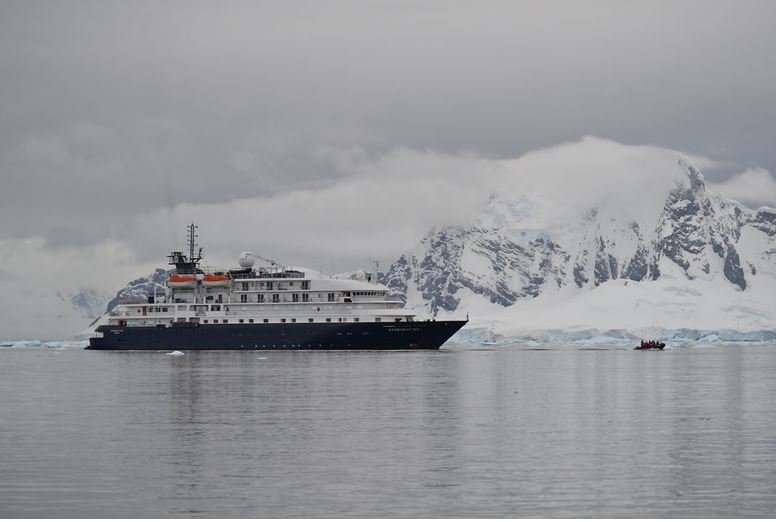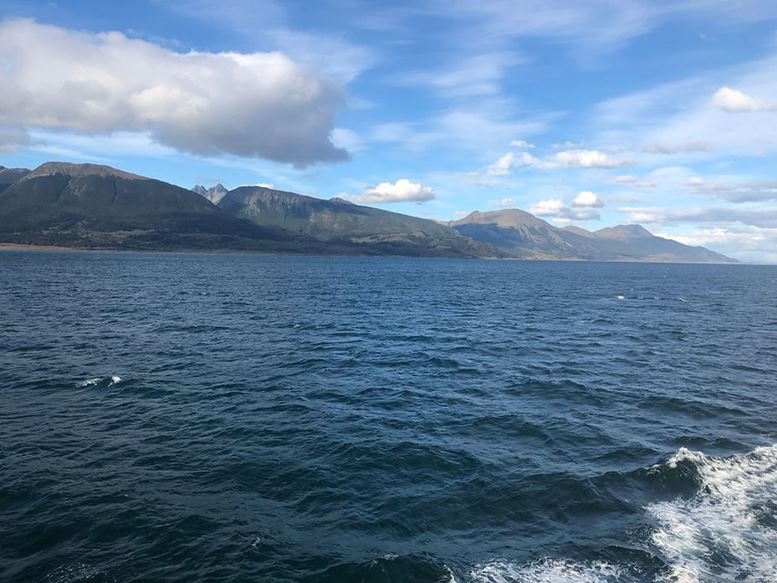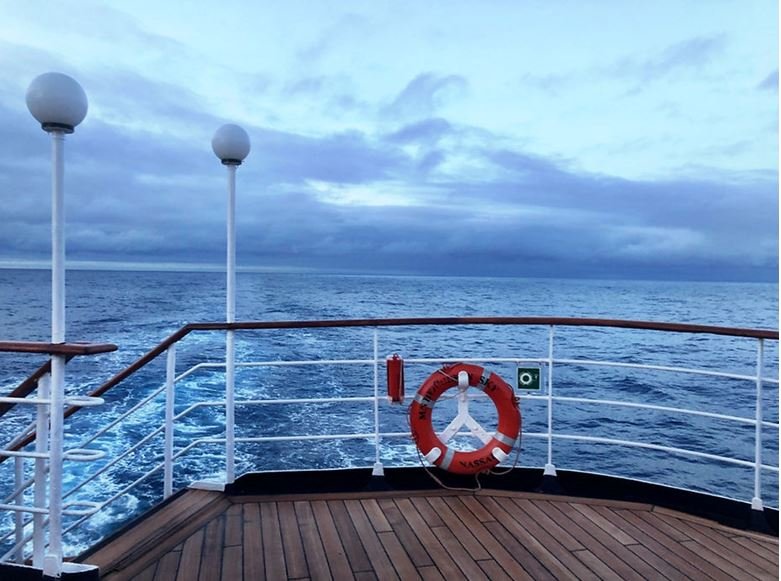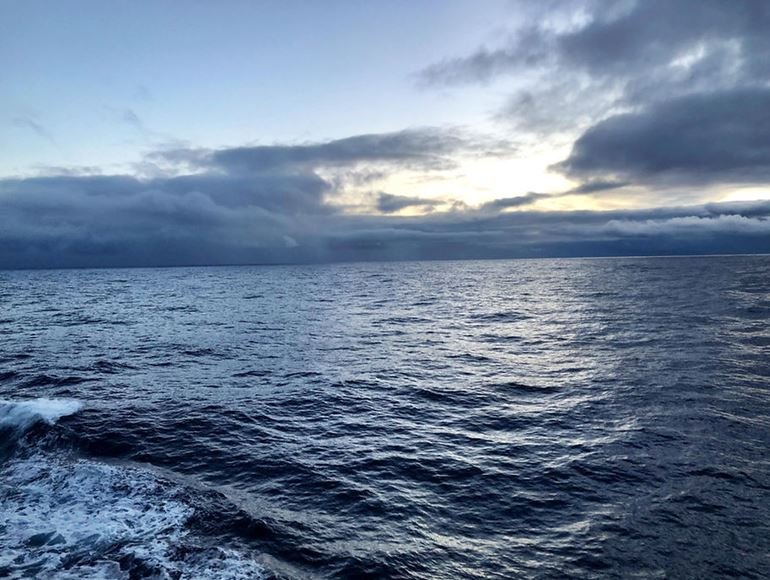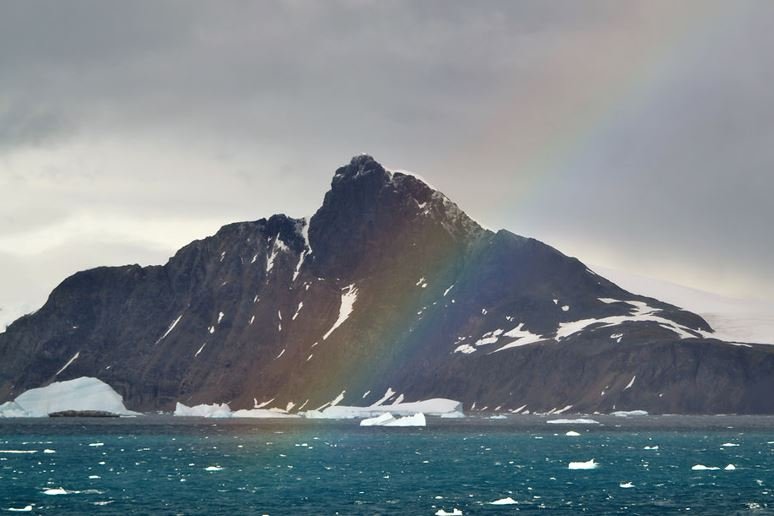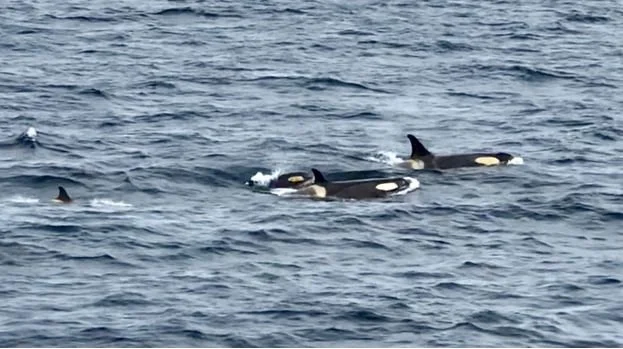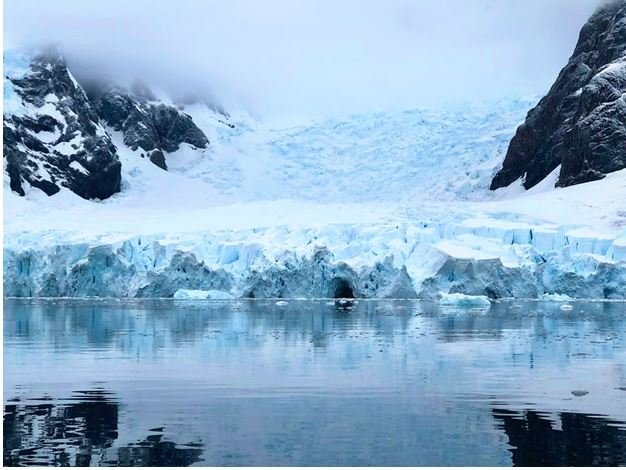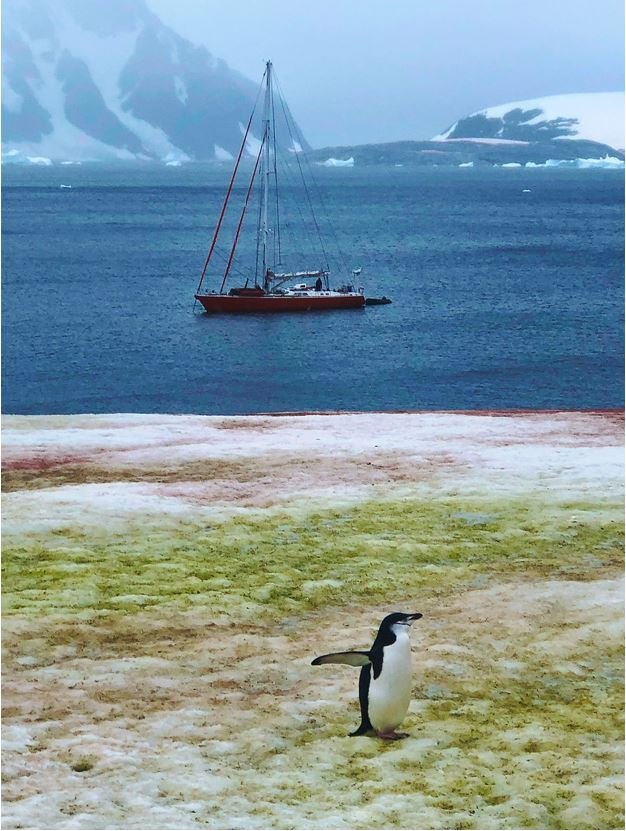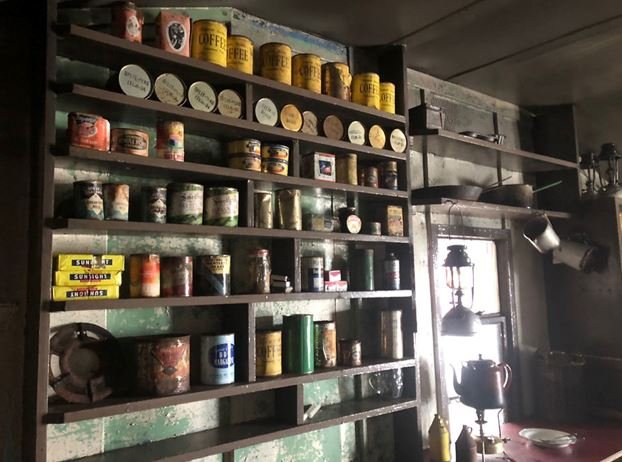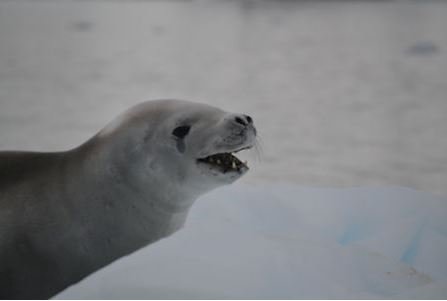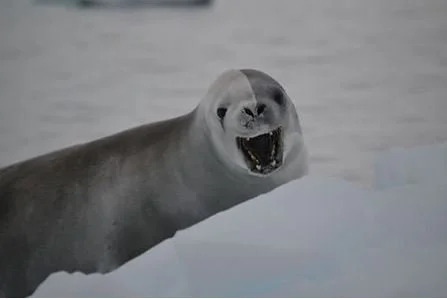Antarctica
I never thought I'd be typing this, but I did it. I went to Antarctica! It was by far one of the coolest trips I've ever been on and I cannot recommend visiting enough!!! As only 40,000 people visit Antarctica a year, there are not as many resources to research as a typical location offers. I hope this post can help since my guess is you probably have a LOT of questions! I'll start with going over our trip from a day-to-day basis. Then I will share info on our tour company, staff, ship, etc. Third, I will share a bunch of pictures because while reading about Antarctica may be fun, seeing what Antarctica has to offer is so much better! Finally, I will provide a Q&A from an email inquiry my bestie sent me. If you have any additional questions, please feel free to email me at blondevoyageesq@gmail.com.
1. Our trip: February 26 - March 8, 2018
Day 1: Leaving Ushuaia and the Beagle Channel
Our trip began in Ushuaia, Argentina. The majority of Antarctica expeditions will leave from this location as it is the closest to the continent. There are also trips that depart from South Africa and New Zealand, but the days at sea to get to land are longer. Look for a later post on Ushuaia and Buenos Aires (our flight from the U.S. landed in Buenos Aires, so we took advantage of that and spent a few days there first). We boarded our ship around 4:00 pm on Monday, February 26, 2018 and departed shortly thereafter. The weather in Ushuaia was beautiful so we had a really picturesque sail out of Argentina on our way towards Antarctica through the Beagle Channel. It takes a few hours to get through the Beagle Channel to the Drake Passage, so there was a lot to see on this leg of the trip from the picturesque mountains of Argentina and Chile, to islands filled with seals, penguins, and even some humpback whales peeking up here and there. It was a great start to what would be an amazing expedition!
Day 2-3: Drake Passage
Prior to this trip I knew nothing about the Drake Passage. The Drake Passage is the area of water between Cape Horn and the South Shetland Islands. This "passage" connects the southwestern part of the Atlantic Ocean with the southeastern part of the Pacific Ocean and leads into the Southern Ocean. In our initial briefing before we left Ushuaia, we were instructed to "Drake Proof" our rooms and to make sure we took our seasick medication. It was then that the horror stories began from passengers who has read stories or heard stories from friends who had taken the trip south. Needless to say, I was prepared for the worst! Luckily, we ended up having the "best passage" ever on our journey to Antarctica. The return is a whole other story......more on that later ;)
With two full days at sea, the expedition team on our ship made sure to fill our days with lectures, bird watching, science experiments, and whale watching. Our seasick meds worked perfectly and we never got sick! It was fun to walk around the ship though when we were at the roughest spots (again, nothing compared to the return!). It was like being really drunk without the hangover the next day. There are several seasick medications on the market as well as a patch. We used Bonine since both my brother and I have used that in the past on sailboats and it has worked. The plus for Bonine is that it is non-drowsy. There were several people on the boat who took medications that caused them to be very sleepy and they ended up in bed most of the day. I definitely recommend Bonine so you don't miss anything on board or outside. You can find Bonine at your local pharmacy (over the counter) like CVS, Walgreens, and RiteAid. It is a chewable tablet that you take 1-2 hours before your journey (or before the rough seas will hit) and it lasts 24 hours.
I'll admit that two full days at sea started to get to me since no matter where you looked you only saw water. By the time we reached our first destination in Antarctica I was very excited to not only see land, but to get off the boat!
Day 4: Cierva Cove and Enterprise Island
Our first excursions off the boat were at Cierva Cove and Enterprise Island. The daily plan on our expedition was one land excursion and one cruising excursion. The total passenger count on our ship was 113, so we were broken into four groups and we'd take turns (two on land, two cruising). For the first day, due to lots of ice, we did not get to actually land anywhere and instead did two cruises. The cruises took place on Zodiac boats. These inflatable boats are the same thing used by the Navy seals, so they are super durable and can get us places a regular boat cannot. They fit about 10 people plus the guide, so you don't feel too crowded. If you're lucky enough to have a fun expedition leader as your guide that day, you may even get to experience a full throttle jet ski-like cruise (shoutout to our guide Adam Rheborg for that one!).
Cierva Cove and Enterprise Island were both filled with beautiful mountains, icebergs, and glaciers. It was also here that we got our first up-close experience with the wildlife of Antarctica. On our first Zodiac cruise we were only a few meters from a humpback whale (the first of MANY humpback whales we'd see on our trip). It was so fun to be that close to such a huge mammal! Most humpback whales are between 40-50 feet, so you can only imagine how massive that is when you're right next to them. It was a game to "find them" after one was spotted. We'd all be looking around like we were playing "Where's Waldo?" waiting to see the water come out of their blowhole. The minute we saw that, we knew we were in for a treat! We learned that the whales eat krill and in order to trap the krill they will create a "bubble net." Basically the whales blow bubbles in a circle under water beneath the krill. The krill are then trapped in the bubble circle, giving the whale easy access to eat them all. We saw this several times, but we also saw whales swimming, breaching, and diving deep (which is when the tail is visible).
In addition to whales, we saw a bunch of penguin chicks that were very curious to see what we were doing. At one point there were about four or five penguins just jumping in and out of the water all around our Zodiac. We were told that the later in the season (late February-early March) is when the penguin chicks are on their own after the parents have left and thus are VERY curious about any and everything they come across. This was extremely evident on land as most came right up to you, some even biting at your pants! (more on that below). The second of our Zodiac cruises that day included seeing an abandoned ship known as the Guvenören Wreck. This old ship was a whaling ship that caught fire in 1915. While all of the crew was able to get off and be rescued by another whaling ship, the vessel has been abandoned ever since. Near this shipwreck were a bunch of seals, giving us more wildlife sightings for our first day of excursions!
Day 5: Cuverville Island and Gonzalez Videla Base
Our first day on land! While the first stop of the day was land, it was not the continent yet. It was still exciting to actually be off water, off a boat, and walking. We weren't sure whether we would have sea legs and be unable to walk, but luckily the island was so rocky that you couldn't walk straight anyways. So perhaps we did have sea legs and just didn't realize? haha
Cuverville Island is penguin central! The island was filled with Gentoo penguins. On our trip we would see Gentoo, Adelie, and Chinstrap penguins. We were instructed by our expedition team to always keep a five meter distance from wildlife, but they informed us that the inquisitive penguin chicks might not care about our rules :) Boy were they right! No matter where you went or how hard you tried to stay five meters away, those chicks DGAF and I loved every minute of it! There were so many penguins and they were so freaking cute. Most of them had molted by now (shed their fluffy feathers), but there were a few that were super fluffy and those were definitely my favorite. At one point I went to take a picture of a penguin and didn't realize I had my camera on "portrait mode." Best mistake ever as it gave me some great pics. How cute are these little guys?
In the afternoon we were supposed to visit Hydruga Rocks, but we quickly learned that in Antarctica, nothing is guaranteed. Prior to getting to Antarctica we were warned that every day would start with Plan A, but there would always be a Plan B, Plan C, and possibly more. Because of the weather, ice, and wind, Antarctica is very unpredictable. This was our first experience with Plan B. There was too much ice for the ship to get to Hydruga Rocks, so they reached out to a local research base and asked if we could visit there instead. They said yes, so we headed towards that area. This was when Plan B ended up being the best thing ever because guess what we saw on our way there? ORCAS!!!!!! We had finished lunch when we were told we couldn't get to Hydruga Rocks and instead we would be sailing south to the base. Since it would be a couple hours, most people went back to their rooms to take a nap. We had just gotten into our beds when our expedition leader came over the PA and said "Orcas have been spotted! Get to a deck and look port side, 10 o'clock!" We jumped out of bed, threw on shoes and coats and ran to the front of the boat. Just as we got out we saw them and it was AMAZING! For me, the top thing on my list for the trip was to see orcas and they did not disappoint. There were five orcas, swimming about 100 meters off the ship. I watched in awe, recording every second, and then they turned direction right to the ship! They ended up swimming right to us and then under the ship. We were told they never get that close and that we were super lucky because the crew hadn't seen any orcas in three seasons! It was so cool to see how excited the staff was to see them as well. Even the captain came out on the bridge and was taking pictures. It was such an added bonus to have an expedition team who was so genuinely excited about what we were seeing. We fed off of their enthusiasm the whole trip.
Plan B was also perfect because not only did we get to see orcas, we got to visit the Chilean research base named Gonzalez Videla, which was on the continent. That meant we finally got to check Antarctica off the continent list!!! The staff photographer had a sign waiting for us to hold to commemorate this feat, which was such a fun idea for pictures. The Chileans were super friendly and answered any questions we had. They also had a very small gift shop and postcards. I sent one from here and am very curious to see how long it actually takes to get to me. The longest I've ever had was almost three years to get from China to a friend in California. Let's see if they beat that record!
Day 6: Paradise Harbour and Plenaeu Island
From a purely scenic perspective, Paradise Harbour was my favorite excursion we did. The waters were super calm, which resulted in absolutely stunning reflective photographs. The mountains and glaciers were gorgeous and it was so quiet and peaceful in this area. At one point, our expedition leader turned off the Zodiac engine and told us all to be silent and just listen. We heard the sound of icebergs breaking off (even though we didn't see where it came from) and it was the creepiest, yet most beautiful sound you can imagine. It was truly like being one with nature in that moment, a thousands miles away from civilization, just taking in the beauty of your surroundings. It was also at Paradise Harbour that we got to visit another research base: Brown Station (an Argentine base). While we didn't interact with the Argentinians at all at this base, there was a small mountain where we were able to trek up and get some great pictures with the mountains and bay behind us. Plenaeu Island offered more beautiful icebergs and glaciers, rounding off a wonderful day off the boat.
Day 7: Port Charcot, Wordie House, Ukraine’s Vernadsky Station
Our next day of excursions ended up being our last (more below), but it was a perfect last day off the boat. We started at Port Charcot which was amazingly gorgeous due to snow algae. Snow algae was not something I knew anything about prior to this landing, but wow was it stunning! Basically there were huge parts of snow that were covered in algae in red/pink and green. Not only did the algae offer unique views, but it was on this island we finally saw the other two species of penguins: Adelie and Chinstrap. There was a sailboat that had sailed from Ushuaia (aka crazy people given how intense the sea can get!) and it made for a great backdrop as I snapped the Chinstrap. This spot also offered a hike to a viewing point which resulted in amazing pictures as well!
Our last excursion was to the Ukraine base of Vernadsky Station. This was a unique excursion because instead of two parts (landing and cruising), there was cruising and TWO landings. The groups were broken down and took turns at all three. Our group got to do a landing, then cruising, then the final landing. The first landing was at Wordie House. Wordie House was a building used by British Graham Land Expedition. In 1954 the Brits left the region and built a base on Galindez Island. The Brits never came back and thus everything inside is what was left after the last group left in 1954. Eventually the land was sold to Ukraine for 1 pound with the conditions that the Ukrainians continue their science experiments. They left Wordie House as is and it is now a museum. They built the Vernadsky base on a nearby island (you can see it from the hill above Wordie House) and the 1 pound coin is memorialized in the bar!
Vernadsky Station was by far the best base we visited not only in size, but because it had a pub! There was a gift shop (the "Southernmost Gift Shop in the World") and the ability to mail postcards (again, let's see how long). We also got our passports stamped at this base, which was so awesome (even if not an official stamp). The pub was super cozy and the Ukrainians make their own vodka. It was very strong, but warmed you right up! Plus, if there is a bar in Antarctica with homemade vodka, how can you actually say no to that?! There was a pool table and dart board to round out the pub and it really made you forget where you were. It was the perfect ending to our Antarctica excursions, even if at the time we didn't realize it.
Days 8-10: At Sea - Drake Passage Nightmare
Day 8 was supposed to be our last excursion day where we would visit Deception Island and take part in a Polar Plunge. Well, due to extreme weather there was no way to traverse the narrow passage to Deception Island. Our team was in contact with another ship which had made their way to Deception Island but ended up getting stuck there because they couldn't get out of the bay. We learned in our briefing that there was a rather large storm moving through and that we would be starting the journey back to Ushuaia a day early because it would take an extra day to traverse the Drake Passage. The weather forecast showed winds over 40 mph and wave swells over 30 feet! While it was slightly disappointing to miss seeing Deception Island, I don't think anyone on the ship wanted to get stuck there, so we were ready to head back. Bonine was consumed and the room was "Drake proofed." We were all so cocky on the way down having experienced what was one of the calmest trips through the Passage. Well, karma definitely got us on the way back! While my brother, dad, and I never got seasick, the trip back was ROUGH. The first night the swells reached 35 feet and since we were at the front of the boat (second to last room from the front), the impact when the ship came back down was intense! Imagine a ship going up 35 feet, then having to come back down to sea level. The noise of the impact back on water so so loud! You could actually feel the ship going up (similar to a roller coaster) and then you'd just wait because you knew the bang was coming. While we didn't get sick, we definitely didn't sleep much that night due to the constant banging. Walking around the ship was pretty much impossible at that point, too. We made it to the dining room for meals, but you didn't want to stay long since the tables and chairs were moving all over the place (even though everything was chained to the floor) and the shuddering was so much worse on the lower, aft level. It was definitely an adventure getting back!
The one silver lining to three days instead of two days back (we're talking 82 hours straight on the ship!) was that we had to change our course so drastically to avoid the worst of the storm. This resulted in us basically going North instead of Northeast, then turning East to get to the Beagle Channel. Directly North meant we were headed straight for Cape Horn (the southernmost part of the civilized world). Cape Horn is part of Chile and the Chilean government requires ships to keep a distance of no less than 12 nautical miles from the coast. When we finally changed our course to head East towards the Beagle Channel, we were 3 nautical miles from Cape Horn! The captain came on the PA to tell us while we were at dinner. We left the dining room to go up two levels to the deck and right there it was, lighthouse shining! The sun was just about set, so we still had enough light to see and the overall jubilation of everyone on board was insane! I have never been more excited to see land than I was in that moment. It was truly a magical moment with everyone just taking it in (plus, the temperature was about 20 degrees warmer than Antarctica, so we all enjoyed that just as much)! We traversed the calm Beagle Channel through the night and arrived back to Ushuaia on Day 11 (the following morning) after an incredible epic Antarctic adventure!
2. Our Expedition Team: Polar Latitudes
When we started researching Antarctica over two years ago, there were several options to choose from so further research was necessary. First and foremost, we had to determine what time of year we wanted to go. The time of year you go changes the experience drastically. Our travel agent went over Christmas and New Years and she had pictures with blue skies and sun. We had one day of partial sun on land and a couple days at sea with sun. Some days it was so cloudy you couldn't even see the tops of the mountains. Plus, we never saw any stars in the sky until our last couple days at sea close to Argentina. While I wish we had better weather, I'm so glad we went when we did because of the animal sightings. Like stated above, the end of summer is when the adult penguins have already left and the chicks were molting and are super inquisitive/brave around people. As for whales, the later in the season, the more you'll see them because they're eating as much as possible before heading north. We saw more whales than they had in a long time and seeing orcas was definitely only possible because of the time of year. When they are spotted (again, first time in 3 seasons) it's always at the end of summer (late Feb/early March). So while it may be warmer and clearer weather earlier in the season, the animal sightings seem much better the later in the season.
Next came price, which be warned is a LOT (minimum is about $8,000 per person). For us, we were a group of three, so we needed a boat that offered a triple suite. Not every ship has triples, so having to book a regular room and a single supplement room can add up quickly! We ended up going with Polar Latitudes because of their pricing. They were the most reasonably priced option (which is still expensive) and they had two triple suites. Plus, if we booked before December 31, 2016 (yes, planning was super early for this one), we would receive a discount of $1500 per person. They only required a small deposit at the time of booking, with the total being due over a year later. This was also key for us in our decision since we had time to save for the remaining balance. Included in the price was hotel accommodations in Ushuaia, Argentina at the beautiful Arakur Hotel, all meals, transportation to and from the ship on embarkation/disembarkation, waterproof boots, and a really nice jacket (we got to keep the jacket valued at $500!).
After time and price, we wanted to make sure that the ship we chose would offer as much to do as possible and that we'd get to step on the actual continent. Every ship states in their sample itineraries that everything is based on weather, which we now completely understand. Polar Latitude's sample itinerary offered the most options for landings and that was very promising. Little did we know we'd get on land numerous times! In addition, Polar Latitudes offers a unique opportunity on their cruises known as "Citizen Science." This program is offered on board to anyone interested (free of charge, just have to sign up for activities) in which you get to participate in science experiments. These ranged from bird surveys, cloud observations, taking water samples for phytoplankton surveys, and noting markings on whale tails. It was nice to offer this extra opportunity to aid in research and help make a difference in protecting this region of the world.
What we didn't research ahead of time, but turned out to be amazing, was the staff. The entire crew of our ship was phenomenal. From the Expedition Team who were so enthusiastic and knowledgeable, to the dining room staff who were on top of their game providing A+ service, to the hotel/laundry staff who kept our rooms impeccable, to the captain and his crew that made the worst Drake Passage crossing ever somehow manageable, they were all incredible. When you're on a small ship for 11 days with the same people, you get very close to them, to the point of feeling like family. I can't imagine a better crew than what Polar Latitudes offered for this once in a lifetime experience. Most of the Expedition Team had been doing these trips for over a decade, so they are well versed in the ways of Antarctica. It was because of their close relationship and experience with the continent that when Plan Bs and Cs were needed, we were not disappointed. Calling the Chilean base and asking if we could visit would not have been possible without the trust the team has built up with the "locals." Polar Latitudes also made sure that when we were stuck on the boat for the days at sea, we were never bored. Whether it be the lectures, movies, presentations, activities, or on-board musical entertainment (Randy, we love you!!!), there was always something to do.
The accommodations and food were also superb. I've been on two regular cruises before this (Royal Caribbean and Norwegian), so I was expecting similar cabins and buffet-style meals. Our ship (the Hebridean Sky) was so much fancier than I expected! The cabins were very well decorated, the bathrooms were a nice size, the toiletries provided were of great quality, the common areas were very nice, and the food was unbelievable! We had a five course meal every night for dinner and each night kept getting better. Our last night included Lobster Thermidor and OMG was it tasty!!! We also had the best server at our table (Hey Richmond!) who took care of us so well. One night our table (8 of us, who became our little crew on the trip) couldn't decide on which dessert we all wanted, so Richmond brought every one of us all three desserts! I miss those meals so much! haha
And as an added bonus, upon disembarkation, Polar Latitudes provided every passenger with a USB stick that included everything from our trip (maps, daily menus, daily programs, etc.) and photographs from the staff photographer in a great slideshow. There is so much to see and remember on a trip like this, so I love that we had everything documented and provided to us. It is the little details like this that turn a great trip into an amazing one!
You can find out more about Polar Latitudes here :)
3. Pictures
SO MANY PICTURES! I took over 1200, so here are just a handful of my favorites :)
His body is different colors from one side being wet & the other dry!
My brother took this pic & actually won a photo contest on board with it!
4. Questions & Answers - please email me if you have more!
What kind of seals did you see? We actually saw 5 species: Weddel, Crabeater, Antarctic Fur, Leopard, and Southern Elephant.
What are the whales doing in that part of the world during this time of the year? Breeding/feeding? Humpback whales will make their voyage north along South America as Winter approaches, so this time of year they're eating as much krill as possible because they will not eat for 5-ish months until they come back south. As for orcas, the ones we saw are called "Type B" orcas. They actually have a more brown appearance because of algae that builds up on them in the Southern Ocean. If you look at the one photo of the close up from above you can see the brownish color. These orcas live in the region year round, but are most active at this time of year which is why we lucked out and saw them!
Did the team on the boat learn anything new on your trip? I'm not sure if they learned anything new per se, but they saw way more than they normally do. They hadn't seen orcas in three seasons! Plus, they rarely see so many seal species in one expedition. The thing they all really geeked out about was seeing Cape Horn since the normal path back to Ushuaia never gets near that area.
Why are orcas traditionally in this area? See above about "Type B' orcas (aka Antarctic Orcas)
Were the beds comfy? I actually lucked out and had the comfiest bed. The triple was two regular beds like every room had and then they made the couch into a bed. The regular beds were very firm mattresses, but the mattress top for the couch bed was much softer. Plus, I was up against the wall so when we experienced the worst Drake Passage ever I was lucky to have something to lean on to keep me in bed!
Was the jacket warm? The jacket by itself would not be super warm. It is not lined with any fabric, but it has a lot of cool pockets and a hood. We would layer a lot of things under them depending if it were a land excursion or a Zodiac cruising. I had a Nike long-sleeved shirt that has this inner lining to keep you warm. On top of that I'd have a long-sleeved shirt and then a fleece zip-up. My body was never cold, just my hands and face from the wind when cruising.
What was the name of the really large glacier in a lot of your early pics? The glaciers didn't have names. Perhaps that is a thing, but no one on our Expedition Team ever called any glacier by name. Just different names for the types of glaciers/icebergs. My favorite term is "bergy bit" which is (google definition) "a medium to large fragment of ice. Its height is generally greater than three feet but less than 16 feet above sea level and its area is normally about 1,076-3,229 square feet." Also, there were a few "iceberg graveyards" which were areas with multiple icebergs in one location.
What excursions did you do? Did you see any whales from the dinghy? Each day they planned one on land excursion and one cruising excursion. We learned quickly that every plan in Antarctica needs a Plan B, C, and possibly more. We saw so many whales from the Zodiacs (the name of the dinghy lol). Antarctica is very unpredictable, especially later in the season, but so worth it because the days we ended up on plan B or C were awesome. One whale (you'll see the photo of the nose popping out with all the bumps) swam all around us and then popped up (it's called spyhopping) and that was amazing! My favorite thing was when you'd be cruising and then you'd hear the puff from the blowhole and it would be RIGHT behind you!
Was the water clear? The closer to land it was extremely clear. Out farther it wasn't as clear, but so much bluer than I expected. And right near the icebergs the water would look turquoise because the water is so clear and the under part of the iceberg would show through and appear turquoise.
What’s the name of the Matterhorn looking mountain in a lot of your pics? Again, we weren't told names of any mountains, just the name of the area of land we stopped. The particular picture you're talking about was in the Paradise Harbor area.
Did they point out any global warming damage? There wasn't any type of "this used to look like this and now it's like this" type of thing. However, we definitely saw glaciers with ice breaking off and we heard A LOT of this without seeing it. It sounded like an old hotel in Vegas being demolished or a bomb. It was really cool to hear but super sad knowing what was happening. We did watch an amazing documentary on board during one of the three return sea days called Ice and The Sky. It is about this French scientist Claude Lorius who basically proved climate change is real from digging thousands on meters into Antarctica and retrieving ice from as far back as the ice age. Then he'd evaluate the bubbles in the ice and essentially was able to prove what the temperature at the time was and showed that while it is true that the climate changes over thousands of years up and down, the last 100 years with the invention of CO2 omitting things, it's gotten way off course. Highly recommend watching!!!
Any fun people on the boat? SO MANY! We were actually the youngest boat they'd ever had in the history of the company. Generally the average age of passengers is 70. On our boat, about half was under the age of 45. Most were about late 20s-late 30s. There were a good 10 or so solo travelers and then a group of girls from Australia that were the life of the party. There were also some couples on their honeymoons. How cool is that? We basically became the party boat with parties in the "club" every night until midnight or later. The entertainment guy was Randy and he was highly entertaining. He would sing "My Heart Will Go On" and would put a life jacket on and changed the lyrics from "safe in your arms" to "safe in life jacket." You couldn't understand most of what he said, but it was so entertaining. And he had these amazing satin ruffled shirts in different colors. It was funny too because the staff were obviously excited to have young people on board. They drank with us and on the excursions they did more than they normally do.
How many boats were in the area? Do they limit the number of boats per day? We actually never saw any other boats. Apparently they plan out their routes TWO YEARS in advance. There are a limited amount of companies that are permitted to be in the region and so they all coordinate two years in advance with their itineraries so that there are never more than one in the same area. I loved that.
Do the penguins migrate or do they stay around that same area? They migrate depending on the type of penguin. We were there at the time of year when the adults had already left and it was just the chicks molting (losing their fluffy feathers). I'm so glad we were there at the time of year we were because I guess they're at prime "inquisitive" age so they were very interested in us and trying to figure out who we were. If the adults were still there or if they were younger, they wouldn't have been as brave.
Are the whales all humpback or do other whales migrate down here too? We saw Humpback, Minke, and Fin whales. Blue and Sei whales are also in the region but we didn't seen any of those.
Tell me about the ice algae? How does it survive such harsh climates? Why is some red and some green? I'll let this article explain better than I can http://www.antarctica.gov.au/about-antarctica/wildlife/plants/snow-algae I can just say it was GORGEOUS!
Do the penguins or seals eat the algae? No, the penguins only eat fish and krill and the seals eat fish and some types (e.g., leopard seals) eat penguins if they can get them.
Bon voyage!

